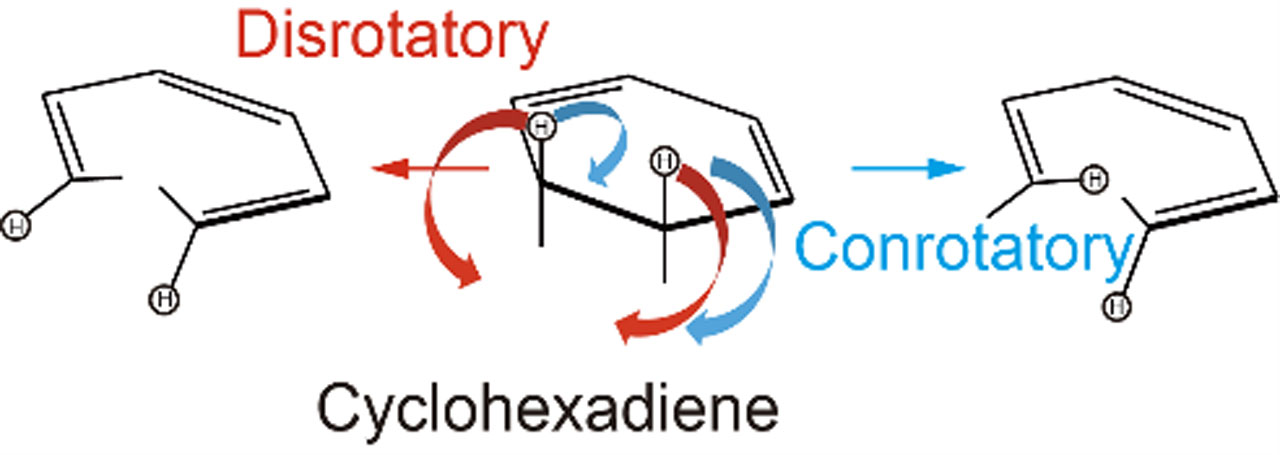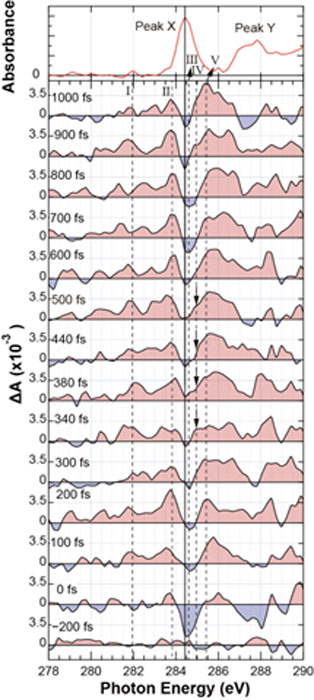Real-Time Observation of the Woodward-Hoffmann Rules for 1,3-Cyclohexadiene by Femtosecond Soft X-Ray Transient Absorption
Itatani Group
The stereochemistry of pericyclic reactions is explained by orbital symmetry conservation, referred to as the Woodward-Hoffmann (WH) rules. Although these rules have been verified by the structures of reactants and products, the temporal evolution of the orbital symmetry during the reaction has not been clarified. Herein, we used femtosecond soft X-ray transient absorption spectroscopy to elucidate the thermal pericyclic reaction of 1,3-cyclohexadiene (CHD) molecules, i.e., its isomerization to 1,3,5-hexatriene. In the present experimental scheme, the ring-opening reaction is driven by the thermal vibrational energy injected by photoexcitation to the Rydberg states at 6.2 eV and subsequent femtosecond relaxation to the ground state of CHD molecules. The direction of the ring opening, which can be conrotatory or disrotatory, was the primary focus (see Fig. 1), and the WH rules predict the disrotatory pathway in the thermal process.
We focused on the K-edge absorption of the carbon atom from the 1s orbital to vacant molecular orbitals around 285 eV, because the K-edge absorption energy depends on the local environment of a carbon atom and could be sensitive to the transient molecular structure [1]. We expect to identify the transient molecular structures by the K-edge absorption. The BiB3O6-based optical parametric chirped pulse amplifier is used to produce carrier-envelope phase-stable intense infrared pulses (center wavelength 1.6 μm, pulse energy 1 mJ, pulse duration 10 fs at 1 kHz). This output is focused into Ne-filled gas cell to produce soft-X-ray continua covering the carbon K-edge, and the transmitted spectrum through the CHD-filled gas cell is measured by a grating spectrometer. The second harmonic (wavelength 400 nm) from the Ti:sapphire laser amplifier is used to pump the CHD molecules by two-photon absorption. Figure 2 shows the stationary carbon K-edge absorption spectrum of CHD (upper panel) and the time-resolved difference spectra (ΔA) at the designated delay time (lower panel).
The ultrafast relaxation from the Rydberg states to the ground state with a time constant of 26 ± 7 fs is identified by the disappearance of the bleaching of peak X observed at 0 fs. Another interesting feature in the time-resolved ΔA spectra is that the induced absorption band temporally appears between 340 and 600 fs at a higher absorption energy than peak X indicated by the arrows in Fig. 2. A theoretical investigation predicts that the transient molecular structures along the disrotatory pathway have higher K-edge absorption than peak X, while those along the conrotatory pathway have lower. Therefore, we attributed the observed induced absorption to the structural change in the disrotatory pathway, which is consistent with the prediction by the W-H rules. The observed dynamics show that the CHD ring starts to open approximately 340 fs later upon photoexcitation. This agrees with the observations by time-resolved photoelectron and high-harmonic spectroscopies [2, 3].
References
- [1] T. Sekikawa et al., Phys. Chem. Chem. Phys. 25, 8497 (2023).
- [2] R. Iikubo et al., Faraday Discuss. 194, 147 (2016).
- [3] K. Kaneshima et al., Opt. Express 26, 31030 (2018).


